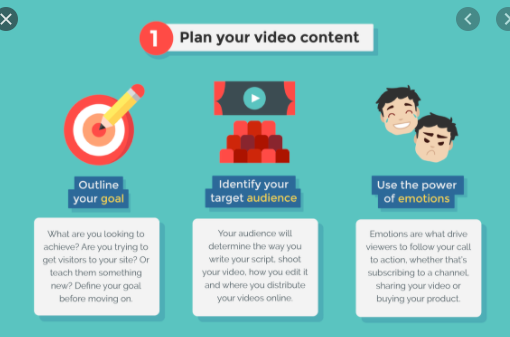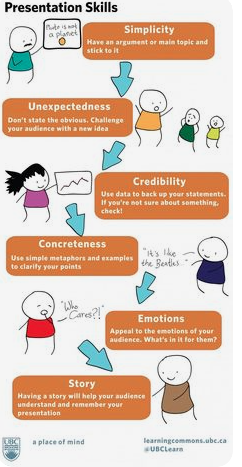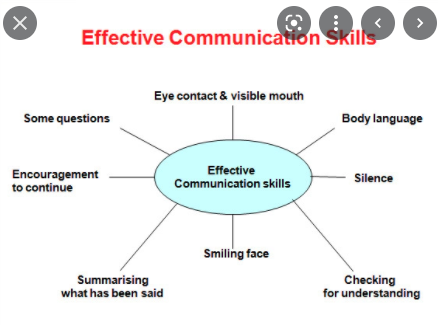8C2 Global Studies
Section outline
-
Kia ora students and welcome back to school. I trust that you all had a fantastic summer holiday and are recharged to begin your'e learning. This term our Context is Think Global act Local, where will will explore how local communities can benefit from business ideas that are marketed to consumers nationally or internationally.
However, as we enter a very import week in New Zealand History, we will examine the Treaty of Waitangi and its significance to us as youth living in NZ today.
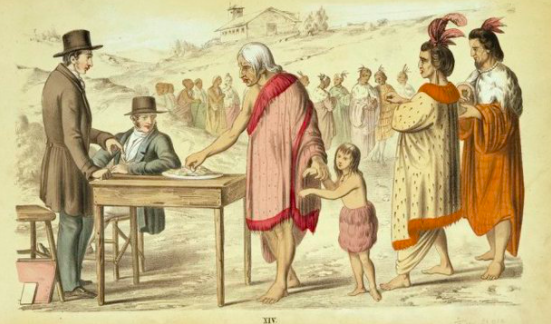
Success Criteria: I can/have...
*Researched the cultural identity of Maori and British cultures from the past to the present
*creatively design a digital cartoon or storyboard that explores early settlers and the Treaty of Waitangi and shows my values that connect with the Treaty.
Activities:
- This week is an important one for our country as we celebrate the Treaty of Waitangi on the 6th of February. Your task is to research a speech ( 2019 or 2020) delivered by our Prime Minster Jacinda Ardern and discuss the key messages she has delIvered on this monumental day. What are your views on our Prime Ministers speech.
- Watch video on Early Maori cultures in NZ and answer the following questions; When did Maori people arrive in NZ and from which locations in the world.How did they arrive here. Describe the waka. Discuss the types of tribes found at that time and where did they settle. Discuss the foods Maori eat and how they collected as well as prepared traditional foods. Show the cultural dress/ music/ art and dance that is symbolic to them. What are the languages spoken.
- Examine the conflict between British and Maori people.Also explain with images the meaning of the treaty of Waitaingi.
- Do you think Maori cultures identity today is the same from few hundred years ago. Explain. Also show how the "west has influenced local Maori Identity.
- how does this treaty have greater significance to our multi- cultural society today. Think of values and connect your reasons to this.This must be explored in good detail.
- Indicate your information on a story board. See example in the classroom.
- Can you express how Me in Team ties in with the Treaty of Waitangi.
Resources:
The Maori - New Zealand in History
history-nz.org/maori.htmlwww.canva.com › create › storyboardsFree Online Storyboard Maker: Design a Custom Storyboard ...
EXPLORE / TŪHURA learning intentions:
- We are EXPLORING...to investigate students personalised immigration story and the vocabulary associated with this idea
- We are EXPLORING...to research the Treaty of Waitangi and its significance for us today in NZ
- We are EXPLORING...to discover the skills required to camp and research information on Camp Adair
EXPLORE / TŪHURA learning intentions:
- We are EXPLORING...the meaning of Think Global Act local and vocabulary that link with this idea
- We are EXPLORING...to connect this ideas to localised examples in New Zealand and our community
- We are EXPLORING...Recognise everyday people who made a difference in their community
-
Kia ora...welcome to week 2. For this week we will explore the learning context Think Global and Act Local. With this idea our intention is to create links with business and innovating a product or service that would be useful to our community.
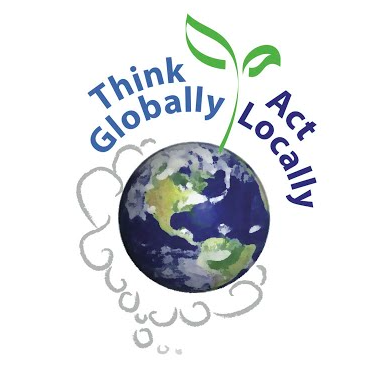
Success Criteria: I can/have...
- an understanding of THINK GLOBAL AND ACT LOCAL BY MAKING CONNECTIONS TO IDEAS THAT ALREADY ARE IN PRACTICE
- brainstormed key words that link with our context as well as to business and marketing.
- created a list of ideas of innovations that may serve useful to our community.
Activities:
- Through a class discussion what is meant by Think Global and Act local. Can you give examples.
- Write down a list of words that connect with this context. Also think of words that connect with business.These are relevant as our learning journey will focus on a business idea that will hep improve the lives of a group of people or evn a community at large.
- "
The phrase 'Think Global, Act Local' was first used in the context of environmental challenges. If you wanted to achieve change and improvement, you couldn’t wait for global legislation or global action. The best course of action was to drive change yourself. You could act to reduce your own environmental impact e.g. by consuming less energy or water. Acting locally starts to address what you see as a global issue." With this is mind, we will think of ways of connecting with our community through actions that benefit a wider group( economically/ socially and even emotionally.
Research the many international brands that have been Globally recognised and made a local impact 4g MacDonalds and Red bull.
See whiteboard on the many ideas people have come up with to create businesses that improved poor villages/ and communities. It takes leadership and commitment form just one individual to make a change.
Do you think teamwork and leadership are important characteristics to have to ensure projects/ businesses are funCTIONING. successfully. Discuss your answer. ALSO RESEARCH THE CHARACTERISTICS OF GOOD LEADERSHIP AND TEAMWORK.
Homework:
Write here...EXPLORE / TŪHURA learning intentions:
- We are EXPLORING...the meaning of Think Global Act local and vocabulary that link with this idea
- We are EXPLORING...to connect this ideas to localised examples in New Zealand and our community
- We are EXPLORING...Recognise everyday people who made a difference in their community
-
Kia ora...students and welcome to week 4. For this week we will explore the problems the challenges brought to New Zealands during the Covid pandemic. In particular to focus on the economic problems people are facing.
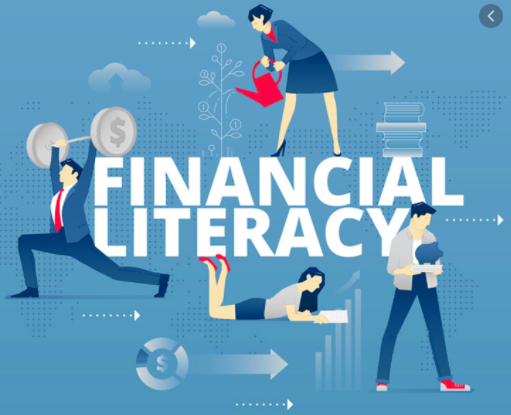
Success Criteria: I can/have...
- Made a connection of Think Global Act local with New Zealanders, in times of Covid pandemic
- Understood concepts liked to our economy
- researched the problems , impacts and consequences Covid 19 has had onto the economic status of people in NZ
- Researched data to have a deeper understanding of this idea
Activities:
- This week we will draw connections on how a global problem such as the Covid 19 pandemic has had impacts on Kiwi people, Draw a table into two coloums and 5 rows. Each column is tilted Social Impacts of Covid 19 and Economic Impacts of Covid 19. Research these impacts.
- Indicate the many consequences that Covid 19 has has onto people and the economy of New Zealand. Think of at least 4 ideas.
- What are your views about this?
- Research what support has been provided to Kiwi's out of work during the pandemic from government as well as private organisations. Eg think of food banks, support from banks and government aide.
- Refer to this graph and analyse what you see:

- ARE YOU IN SUPPORT OF PEOPLE BEEN DEPENDANT ON GOVERNMENT FUNDS OR To create opportunities for themselves to get through. This is a class debate. You are either for or against.
- In order to support Kiwis during this difficult time, your task is first to learn about financial literacy. a) What comes to mind when you hear the words money management? b) what are the functions of banks? C) List places people can borrow money? d) What is interest and credit?e) List ways you can earn an income? f) What is meant by investment? Define what is business? What is meant by a budget?
- Once you are able to answer the above questions? You need to work in a team and create a budget for the living expenses for a family of five. This family has only one income coming into their household as the main bread winner has been unemployed due to covid 19. Let's say the current income is $3000. Express the budget and explain how would this family get through? Do you think more needs to be done to survive during this time?
Resources:
Why Financial Literacy Is So Important - Investopedia
Budgeting Tool » Sorted
FOCUS / ARONGA learning intentions:
- We are FOCUSING...developing our understanding on the challenges that affect the global and more focused on community issues
- We are FOCUSING...explaining the reasons why the community undergo problems, in particular economic constraints
- We are FOCUSING...on the impacts and consequences of unemployment and other economic constraints
-
Kia ora...students and welcome to week 4. For this week you will focus on business ideas. Your ideas must be well thought of that apply to our community and country. Again, recap the reasons why people are unemployed in nZ and think of ways that are practical and achievable for business ideas to spring up.
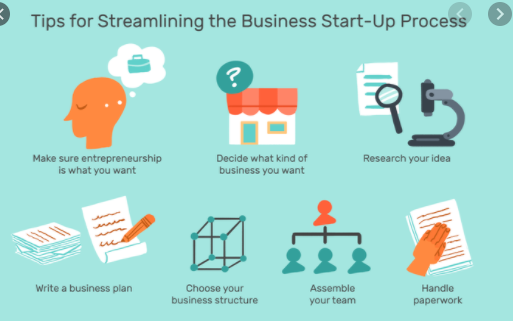
Success Criteria: I can/have...
- Researched successful business that have been started by youth groups in various parts of the world and drew inspiration from these ideas
- brainstormed with my team ideas to kick start a business that is suitable to New Zealanders
- Began to work on a business plan taking into account all criteria to operate a business
Activities:
- See whiteboard on images and stories from the youth across the world that have started businesses form home, and become very successful as a result.
- Research one case study of a youth whom has made an impact in their community or county or even internationally by starting their own business. In your analysis , think of the idea( product or service) , how it began, who was their target audience, price of the product or service.
- With your teams understand what is meant by the 4 Ps of marketing. Discuss and understand this concept in detail as you would apply it to your own business.

- Begin thinking of ideas that you think are suitable to start a business in NZ.As a team decide on one idea that you would use to design a business plan.
- See an example on the white board on how a business plan is created
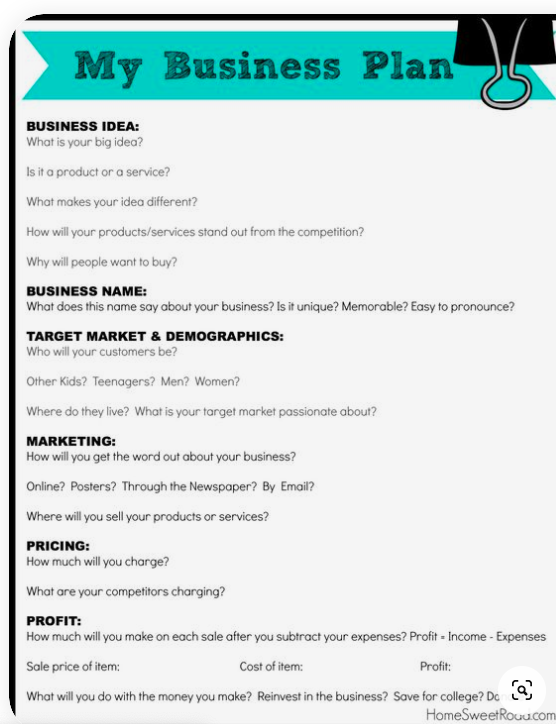
- With this idea, draw your service or product ( with Labels)and discuss why is it relevant/ necessary to support our local community.
- Design a Business Logo, with a business name.
- How many people would be part of your team. What would they earn per hour. What are you total earning projections do you think you would make in a month and in a year? Show working out here.
- Design an advert that would help promote your business.
- Design your packaging and label( sketch/ draw)
- How will your business make an impact in the community
- Design all your ideas in the form of a visual( chart thats ahas a flow to it)
- Finalise your work for submission by start of week 6
Homework:
Write here...FOCUS / ARONGA learning intentions:
- We are FOCUSING...developing our understanding on the challenges that affect the global and more focused on community issues
- We are FOCUSING...explaining the reasons why the community undergo problems, in particular economic constraints
- We are FOCUSING...on the impacts and consequences of unemployment and other economic constraints
-
Kia ora...students and welcome to week 5. For this week you will focus on business ideas. Your ideas must be well thought of that apply to our community and country. Again, recap the reasons why people are unemployed in NZ and think of ways that are practical and achievable for business ideas to spring up.
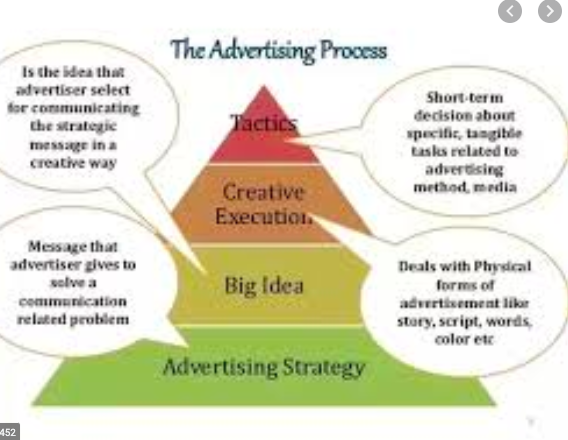
Success Criteria: I can/have...
- Researched successful business that have been started by youth groups in various parts of the world and drew inspiration from these ideas
- brainstormed with my team ideas to kick start a business that is suitable to New Zealanders
- Began to work on a business plan taking into account all criteria to operate a business
Activities:
- See whiteboard on images and stories from the youth across the world that have started businesses form home, and become very successful as a result.
- Research one case study of a youth whom has made an impact in their community or county or even internationally by starting their own business. In your analysis , think of the idea( product or service) , how it began, who was their target audience, price of the product or service.
- With your teams understand what is meant by the 4 Ps of marketing. Discuss and understand this concept in detail as you would apply it to your own business.
- Begin thinking of ideas that you think are suitable to start a business in NZ.As a team decide on one idea that you would use to design a business plan.
- See an example on the white board on how a business plan is created

- With this idea, draw your service or product ( with Labels)and discuss why is it relevant/ necessary to support our local community.
- Design a Business Logo, with a business name.
- How many people would be part of your team. What would they earn per hour. What are you total earning projections do you think you would make in a month and in a year? Show working out here.
- Design an advert that would help promote your business.This advert can be in the form of a banner / advert for Social media eg Face Book or Instagram/ or an advert for a magazine or newspaper.
- Draw/ sketch your product with labels. Also indicate materials used or ingredients used.
- Design all your ideas in the form of a visual( chart thats ahas a flow to it)
- Create a theme to your chart
- Finalise your work for submission by end of week 6. Submissions at start of week 7.
Homework:
Write here...FOCUS / ARONGA learning intentions:
- We are FOCUSING...developing our understanding on the challenges that affect the global and more focused on community issues
- We are FOCUSING...explaining the reasons why the community undergo problems, in particular economic constraints
- We are FOCUSING...on the impacts and consequences of unemployment and other economic constraints
PLAN & DO / WHAKAMAHI learning intentions:
- We are PLANNING... to construct a budget and business plan so that we can design ideas that would help people create businesses so be self reliant.
- We are planning to work as a team and share ideas/ knowledege/ skills so that our outcome looks successful and achievable.
-
Kia ora...For this week you will use your sketch of your product or service to inspire you to make the actual item.This will require your good teamwork that follows a design process.
Success Criteria: I can/have...
- I have created a sketch or drawing of my product or service that includes packaging and labels.
- Working well with my team on collaborating ideas
- Researched ways to have our idea created
- Bring resources to class and began making our product/ model for our service
- Show case our business idea to the class in the form of a marketing event eg: Dragons Den
Activities:
- Redesigned my drawing of our business product or idea. Thinking of ways it may be eco friendly and have a sustainable approach.
- Research how to make our product. This also includes the packaging and labels.
- Research the cost of materials required eg food ingredients, printing of labels and cost of food containers.
- See white board on some your products and how they are made eg candles/ fruit juices.
Showing results for product making on juices
Search instead for product making on juicesProduct ready for HPP. High pressure processing (HPP) is currently one of the most in-demand technologies ...8/11/2019 · Uploaded by Hiperbaric HPPBenefits: Compared to natural waxes, paraffin is a petroleum-based product that takes dye better and ...14/05/2017 - Begin to make your product model to show your service,
- Showcase and market your business idea to the the class using the 4Ps of marketing. This will be done in the form of a Dragons Den way.This will also include testing your product/ service and gaining feedback from your audience.
Resources:
Junior Dragons Den youth business competition for students in Grade's 7 to University throughout the Kootenay's.
Write here...PLAN & DO / WHAKAMAHI learning intentions:
- We are PLANNING... to construct a budget and business plan so that we can design ideas that would help people create businesses so be self reliant.
- We are planning to work as a team and share ideas/ knowledege/ skills so that our outcome looks successful and achievable.
-
Kia ora...For this week you will use your sketch of your product or service to inspire you to make the actual item.This will require your good teamwork that follows a design process. This will you will make and market your product or mode.

Success Criteria: I can/have...
- I have created a sketch or drawing of my product or service that includes packaging and labels.
- Working well with my team on collaborating ideas
- Researched ways to have our idea created
- Bring resources to class and began making our product/ model for our service
- Show case our business idea to the class in the form of a marketing event eg: Dragons Den
Activities:
- Redesigned my drawing of our business product or idea. Thinking of ways it may be eco friendly and have a sustainable approach.
- Research how to make our product. This also includes the packaging and labels.
- Research the cost of materials required eg food ingredients, printing of labels and cost of food containers.
- See white board on some your products and how they are made eg candles/ fruit juices.
Showing results for product making on juices
Search instead for product making on juicesProduct ready for HPP. High pressure processing (HPP) is currently one of the most in-demand technologies ...8/11/2019 · Uploaded by Hiperbaric HPPBenefits: Compared to natural waxes, paraffin is a petroleum-based product that takes dye better and ...14/05/2017 - Begin to make your product model to show your service,
- Showcase and market your business idea to the the class using the 4Ps of marketing. This will be done in the form of a Dragons Den way.This will also include testing your product/ service and gaining feedback from your audience.
Resources:
Junior Dragons Den youth business competition for students in Grade's 7 to University throughout the Kootenay's.
Write here...PLAN & DO / WHAKAMAHI learning intentions:
- We are PLANNING... to construct a budget and business plan so that we can design ideas that would help people create businesses so be self reliant.
- We are planning to work as a team and share ideas/ knowledege/ skills so that our outcome looks successful and achievable.
-
Kia ora...we will focus on ideas beyond our community related to the globe.
With our context: Think Global Act Local: we will discuss and evaluate Are we a Global Citizen?
In teams select on Sustainable goal you want to address. What does your goal mean. How is it not achieved? As a Global Citizen, you will consider taking action to resolve this issue, one step at a time can make a difference.
Success Criteria: I can/have...
- I have understood what the UN Sustainable goals mean and linked to examples in the world
- My team and I have chosen one Sustainable goal and connect to One case-study or country in the world.
- Create a video that addresses the problem and the sustainable steps you would inform global audience to take, to reduce the problem identified.
- Show case you video in class and be open to discussions and debate.
Activities:
1) Let' s view the UN Sustainable Goals. See video and images on the white board that help you understand what these goals mean. Connect this to real life problems in the world.
2 By choosing a case study ie (one country where the goal is not achieved) Research and create a video using the following information:
What is the problem
Who is the main cause of this issue
What effects does it have onto the environment and other people.
HAS ANYTHING BEEN DONE ABOUT IT EG THROUGH GOVERNMENTS OR NGOS, OR LOCAL HEROES IN THE COMMUNITY
Create an informative video showing how we can help reduce the problem you identify.
You must first undertake deep research your case- study/ problem.
What can you do to bring about change... make the situation better.
Example in class: Goal 12: Responsible Consumption and production.
For this we will identify food consumption and production that least to food waste in the world. Specific country will
Resources:

-
Kia ora...we will focus on ideas beyond our community related to the globe.
With our context: Think Global Act Local: we will discuss and evaluate Are we a Global Citizen? Connect this to identifying a global problem and creating a business solution to address it. For this your ideas must have an environmental / eco friendly approach
 h.
h.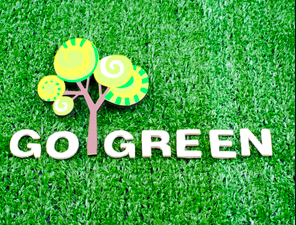
Success Criteria: I can/have...
- I have understood what the UN Sustainable goals mean and linked to examples in the world
- My team and I have chosen one Sustainable goal and connect to One case-study or country in the world.
- Create a video that addresses the problem and the sustainable steps you would inform global audience to take, to reduce the problem identified.
- Ideas should link having an environmental focus
- Business Solutions must be a sustainable approach
- Show case you video in class and be open to discussions and debate.
Activities:
1) Let' s view the UN Sustainable Goals. See video and images on the white board that help you understand what these goals mean. Connect this to real life problems in the world.
2 By choosing a case study ie (one country where the goal is not achieved) Research and create a video using the following information:
What is the problem
Who is the main cause of this issue
What effects does it have onto the environment and other people.
HAS ANYTHING BEEN DONE ABOUT IT EG THROUGH GOVERNMENTS OR NGOS, OR LOCAL HEROES IN THE COMMUNITY
Create an informative video showing how we can help reduce the problem you identify.For this think of idea that link with business that aim to be solutions to environmental crisis
You must first undertake deep research your case- study/ problem.
What can you do to bring about change... make the situation better.
Example in class: Goal 12: Responsible Consumption and production.
For this we will identify food consumption and production that least to food waste in the world. Specific country will be adreessed.
What business idea can you think of to be a solution to any of the above issues. Eg recycling materials to remake into other products, or your redesign of electric scooters, etc. See white board for more inspiration.
Resources:

-
In team show case your video. Be prepared to have discussions and questions form the class.from the class.Your video must be informative that showcases the location, problem and consequences of the environmental issue you have selected. More importantly to provide solutions asn ways to reduce this problem. Think of ideas that are realistic, practical l and will promote long term sustainability.
The video must not be longer than 2mins.
Be creative with the use of music, data, interviews, images and Your Voice!!

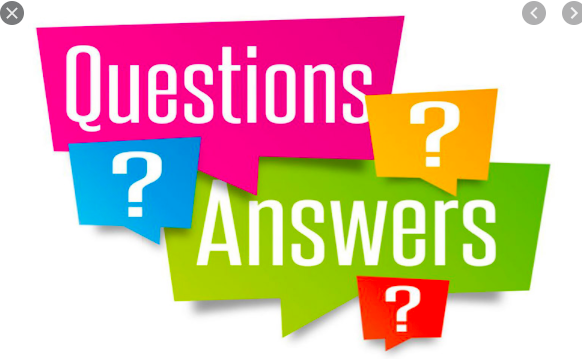
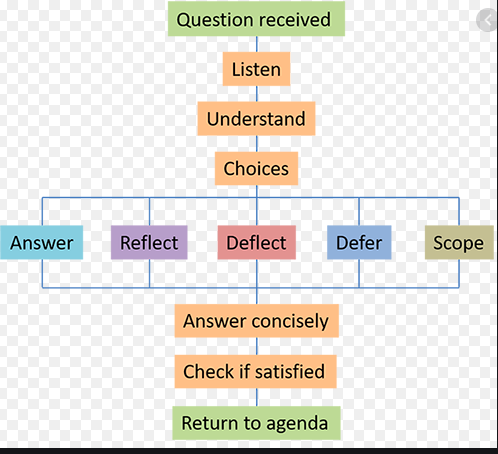
Skills:
Teamwork
Research
Video Creation
Presentation skills: answer questions
Resources:
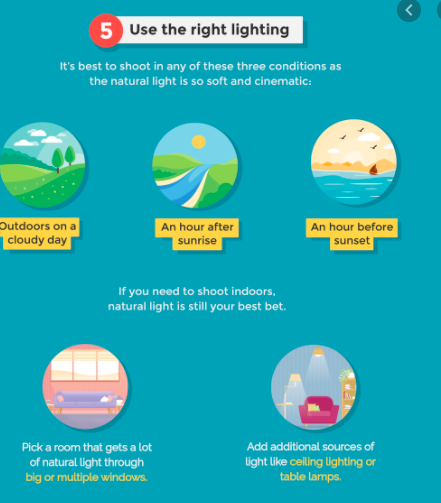
Free Video Maker: Edit Videos Online & Add Music | Canva
How to Make a Video Using iMovie: 11 Steps (with Pictures)
-
Kia Ora Students. For this week we will do a reflection of our terms. Also, I will introduce you to Term 2's learning context.

Quiz: see whiteboard for online quiz as well as crossword puzzles.
REFLECT / WHAIWHAKAARO learning intentions:
- We are REFLECTING...on the challenges we experienced to design a business plan/ team work and the product idea.
- WE are evaluating and critiquing what we could better in the future to produce better results
-
Kia ora...students and welcome to Term 2. I hope everyone had a good vacation and you are ready to take on our new learning context on Taking a Leap with links to Leadership.
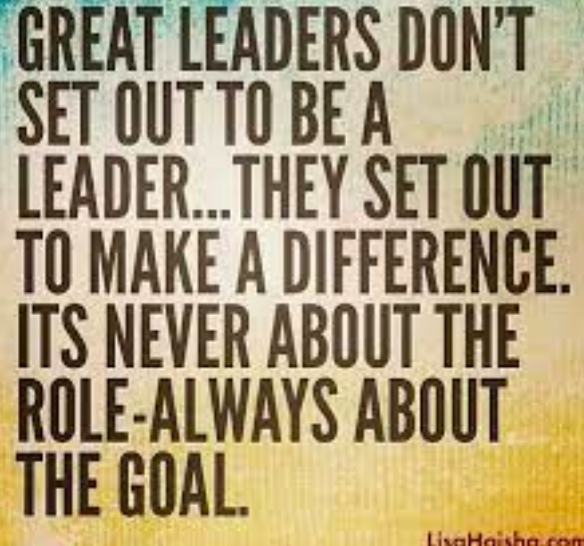
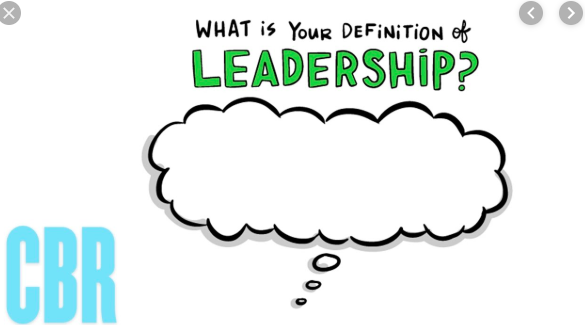
Achievement Objectives: Enter AO's here
Big Idea: Leadershio
Learning Intentions: We are learning to (WALT)...
- to identify leadership traits through leaders you know
- to identify leadership attributes you may have
- discover what makes a good leader and research one such example( in politics/ education/ medicine/ sport/ fashion industry/ youtuber
Success Criteria: I can/have...
- Understand the meaning of leadership and researched the leadership traits of one leader, that will be shared with my peers.
Activities:
- Define what is meant by leadership. Write at least 5-7 words that link wth leadership such as Confidence, rule, compassion, authoritative

- What traits of leadership do you think you have?
- Is everyone a leader? or are there exceptional few people that stand out to have leadership abilities. Explain.
select a leader you wish to research. It can be someone in politics/ media\cine. education/ sports the fashion industry or someone you know personally. Use Internet resources to learn more about YOUR SELECTED leader's life. As you work, identify four leadership traits and examples to include on the Leadership Qualities graphic organizer.
consider the following:
- What elements of leadership are inherent to your leader? How do you know?
- What elements of leadership did your leader learn during his/her life? What events show this learning?
- What examples from your leader's life demonstrate each trait?
- How did each leadership trait affect the leader's ability to have an impact?
- What leadership traits do you share with your leader?
- Record your information using a graphic organizer.
- See images and video on the white board on leaders from around the world past and present. These include Nelson Mandela/ Donald Trump/ Hitler/ Jacinda Ardern/ . Discuss your views on these various leaders leadership styles.
Resources:
The 8 Most Common Leadership Styles & How to Find Your Own8 Common Leadership Styles (and How to Find Yours) - The ...https://blog.hubspot.com › marketing › leadership-stylesMar 26, 2015Remember the good old days, before the age of the celebrity CEO? Before leaders from all sectors didn't ...
Write here...EXPLORE / TŪHURA learning intentions:
- We are EXPLORING...vocabulary linked to people taking a leap in History and researching their leadership styles
- We are EXPLORING...through research what are the various leadership styles and connect the style that best applies to me.
- We are EXPLORING...why leadership can represent both positive change and challenges in the world , thus recognising people that implemented this.
-
Kia ora...students. For this week you will be working on leadership attributes that apply to you/ ideas on what makes you a good leader.
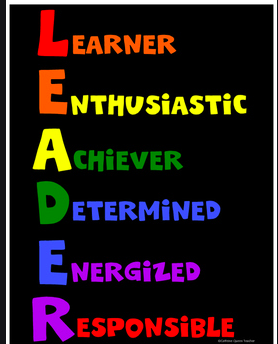
Achievement Objectives: Enter AO's here
Big Idea: Leadership
Learning Intentions: We are learning to (WALT)...
- learning to understand what leadership attributes apply to me
- demonstrate leadership skills through class activities.
Success Criteria: I can/have...
- understood what leadership attributes I have and demonstrated these skills through classroom activities.
Activities:
- Refer to the work sheet below and answer each approach to leadership

2. By working in a team of 4, create a video that demonstares your leadership style/ attitudes and values, whereby you welcome the 2020 year 7 students to Coast Whanau and encourage them on the following
a) friendship building: reporting/ stopping bullying of any kind
b) keeping MHJC / Coast whanau clean: how to use the bins carefully and ways to reduce litter
c) protecting TANE Forest: use with care and respect
3) Create a video that includes a Title page/ 2. minutes footage/ editing/ music/ voice overs and interviews.
4) Showcase your video in week 3.WE will use these for next year's new student arrivals.
Resources:
Write here...EXPLORE / TŪHURA learning intentions:
- We are EXPLORING...vocabulary linked to people taking a leap in History and researching their leadership styles
- We are EXPLORING...through research what are the various leadership styles and connect the style that best applies to me.
- We are EXPLORING...why leadership can represent both positive change and challenges in the world , thus recognising people that implemented this.
-
Kia ora...students and welcome to week 3. For this week we will explore in detail what the contextlEADERSHIP. The ideas we will draw reference to include people as leaders in business, politics, sports, communities. and as the youth.
However we take a pathway on focusing is on problems in our communities and looking at different roles models that help address these issues. We will focus on our commitment. to help our community thrive and shine.
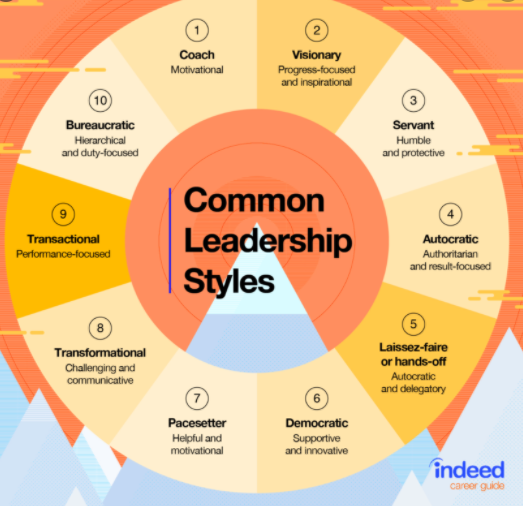
Success Criteria: I can/have...
- Brainstormed ideas that link with Leadership
- Determine what is leadership and team work.
- I have researched what are the different leadership styles and views one each style.
- Connect people that are linked to the various leadership styles
Activities:
- Watch the Video on teamwork
Express why team work is both important and challenging.
Think of the many ideas that link with teamwork as well as leadership. Do you think there is a place for ME in the concept of Team. Explain with examples why me is relevant.
Read this document on leadership styles and answer the table below:

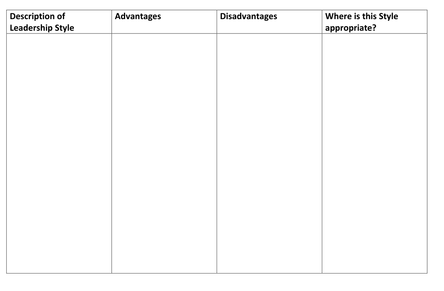
5. See the whiteboard on a range of famous people that have lead a team and contributed to success in the country or globally. Who stands out to you the most based on their style of leadership and why? ( ideas include Oprah Winfrey. Richard Branson, Richie Macaw, Hitler, Mandela, Donald trump, Malala and Greta Thunderburg. Share, pair and discuss your response.
6. Based on the disadvantages of some leadership styles, which leadership would be most recommended to ensure collaboration, effective management as well as team success.
7. We will begin to take the key components of leadership and the various people that ave offered leadership styles in the world. You are to be in groups and choose one Iconic leader that has made an impact in the world.) ancient, past or present) This leader can be someone in politics, medicine, education a celebrity or sports.Next week you will be given the design template to explore and research your chosen icon.
Homework:
Write here...
EXPLORE / TŪHURA learning intentions:
- We are EXPLORING...vocabulary linked to people taking a leap in History and researching their leadership styles
- We are EXPLORING...through research what are the various leadership styles and connect the style that best applies to me.
- We are EXPLORING...why leadership can represent both positive change and challenges in the world , thus recognising people that implemented this.
-
Kia ora...students. For this week you will research and examine youth leaders had made an impcat in the world.In this case how gender discrimination and religion may play a role in human rights violations. Special interest is given to the case of Malala.
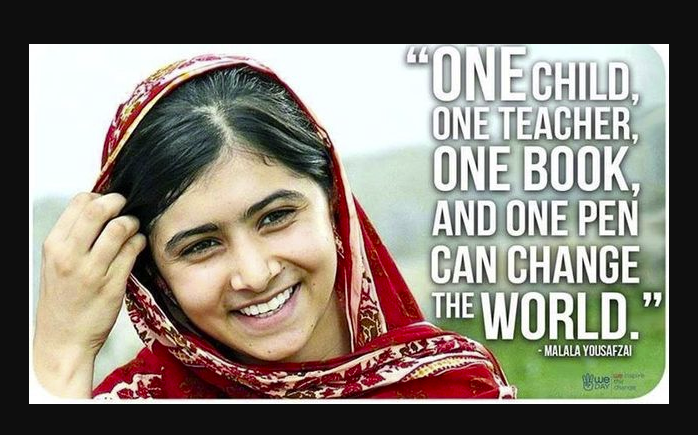
Achievement Objectives: Enter AO's here
Big Idea: I RISE!!!
Learning Intentions: We are learning to (WALT)...
- to explore human rights violation by examining gender discrimination
- examining in detail the case of Malala as a leader.
Success Criteria: I can/have...
- understood key examples of gender discrimination and its consequences
- examined in detail the case of Malala and the consequences of her shooting.
Activities:
- What is gender discrimination and why is this a violation.
- Research an example of how gender discrimination had affected Malala in Pakistan. Why do you think this is a human rights violation.
- Research in detail the case study of Malala. Express your views on this historical incident. How has she used her traumatic event for the betterment of global society today.
- Watch documentary on Malala. Write important points as part of your research here.
- Can you think of other youth that have made a difference in society, where they broke down barriers and become Role models/
- In groups of 5, choose one leaders you would like to research in detail( either in politics, business, sports, medicine or education). Create a visual based on your leader. 9 poster/ slideshow or video. Information should include: Name, country, what type of leadership they they represent, what did they do( positive or negative) explain this in detail. What was the consequences of their actions. Would you consider them a hero or a villain. Explain why. How can we learn lessons from what they represented and brought to communities or the global community.
- This task is due end of next next week, as a group presentation.
Resources;
Malala's Story | Malala Fund
give Malala every opportunity that a boy would have.Homework:
Write here...FOCUS / ARONGA learning intentions:
- We are FOCUSING...developing an understanding on the various leaders in sports, politics, business and education and the changes they brought to humanity( both positive and negative)
- We are FOCUSING...identifying role models in Maori culture and the differences made by them in society
- We are FOCUSING...on presenting these role Maori role models to the class and respond to questions on the leaders I present
-
As a group, presenting your information and research on a youth leaders you had researched.
You will work as team, you will contribute equally to discussions and questions in the classroom.
Make sure you have the following information:

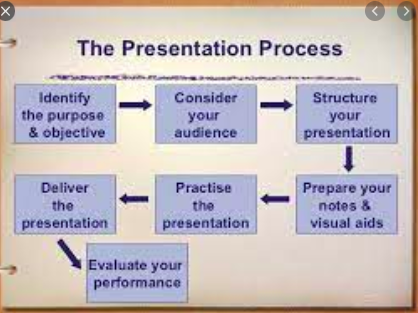
INTRODUCTION, KEY DEFINITIONS, LOCATION( MAP AND FLAG< NAME AND PROFILE OF YOUR YOUTH LEADER, WHAT HAVE THEY ACHIEVED, WHAT STRUGGLES DID HE/SHE UNDERGO, WHY DO YOU CONSIDER THIS PERSON A ROLE MODEL OR SOMEONE TO LOOK UP TOO. WHAT HAVE YOU LEARNT FROM THIER CONTRIBUTIONS TO THIER COMMUNITY OR THE WORLD.
Consider ideas that link with one of the following: politics, education, science, sports, business .
Presetation time is 15mins per team.
.FOCUS / ARONGA learning intentions:
- We are FOCUSING...developing an understanding on the various leaders in sports, politics, business and education and the changes they brought to humanity( both positive and negative)
- We are FOCUSING...identifying role models in Maori culture and the differences made by them in society
- We are FOCUSING...on presenting these role Maori role models to the class and respond to questions on the leaders I present
-
Kia ora...students and welcome to week 6.This week we will explore the many influential people and leaders we look up to in our cultures/ and society at large. We will look at auto biographies of people and discuss what impacts they had on to their families and communities.
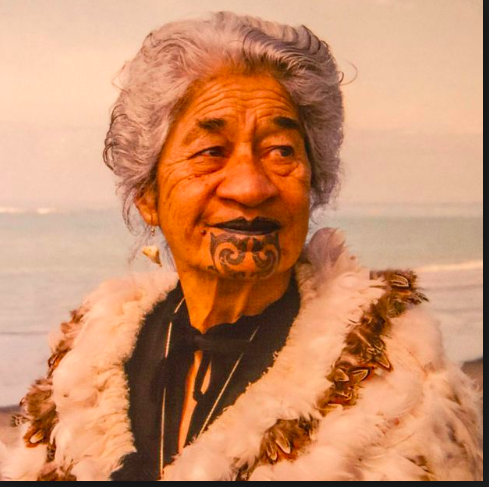
Achievement Objectives: Enter AO's here
Big Idea: Creative Connections
Learning Intentions: We are learning to (WALT)...
- Explore people that made a change in society that may come from cultures connected to us.
- Examine what special characteristics do these people have and why should respect and remember them.
Success Criteria: I can/have...
An understanding of what leadership means and examined a few articles on leaders from our cultures.
Activities:
- What does leadership mean to you? Let us brainstorm a few ideas on the white board?
- Do you think you have leadership skills that have been thought to see by someone important? How do you use these skills?
- Why do you think leadership is important? What advantages can this characteristics bring to us at school/ in our community and as global citizens.
- Watch the video on what is leadership
Discuss your views. - Can you think of examples of great leaders that come form our cultures? Lets us write a list and see images of who they are.
- For this week we will will examine leaders from Maori culture. See the image of Eva Rickard on the board. Discussion on whom she was and how she lead her cultural community, impacts made and will be explored in class. You need to read the artciles beow to be able to contribute to the discussions in the class.
- Actions of leaders from the past certainly have influenced people today. Think of leaders/ or groups of people whom continue to make changes and have their voices heard in todays society in new Zealand. Let us look at the current news from locals in Mangarere whom are protesting the the building of homes by Fletcher Homes, that are planned to be constructed on Maori burial land. What are your views on this?See video on white board.
- Discuss ways in which positive changes are are in local communities because of good leadership skills practiced by leaders/ role models.
- Research one Maori individual that has made a significant impact in New Zealand. Create a visual based on his/ her autobiography: Name/ age/ family background/ What has he or her achieved? impacts into society( positive as well as challenges) Why do we see them as remarkable leaders? Your Views
Homework:
Write here...Being A Leader; A Kid's Perspective – The Principal of Change
4 important leadership skills to teach kids | Young Parents
https://georgecouros.ca/blog/archives/810
https://www.protectihumatao.com/ FOCUS / ARONGA learning intentions:
- We are FOCUSING...developing an understanding on the various leaders in sports, politics, business and education and the changes they brought to humanity( both positive and negative)
- We are FOCUSING...identifying role models in Maori culture and the differences made by them in society
- We are FOCUSING...on presenting these role Maori role models to the class and respond to questions on the leaders I present
-
Kia ora...students and welcome to week 7You task for this week is to research leaders and inspirational people from Maori culture and they impact they may had in society.
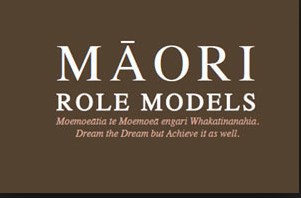
Achievement Objectives: Enter AO's here
Big Idea: Cultural Connections
Learning Intentions: We are learning to (WALT)...
- research role models and inspirational people from Maori Cultures
- to determine what they have achieved and why they may be an inspiration to us
- to create a visual / poster that displays the biography of your inspirational person.
Success Criteria: I can/have...
- researched a role model from Maori culture and created a poster to showcase their live, work and achievements made in society
- Activities:
- Let us create a word bank on words that link with role models and leaders. Also think of words connected to Maori cultural values and ethics eg; respect/ understanding, strength, family,
- See video on Maori culture in New Zealand. in New Zealand. Write down at least 5 ideas from this video.3) See images of the various Maori leaders, everyday heroes in New Zealand. What common characteristics do you they they may have to be an inspirational person or considered a leader.
- 4) By working in team of 3, choose one Maori person that has made a difference in society. He/ she does not have to be a celebrity or famous, but your research shows that this person made a positive contribution to other people.Research the following: Name, age, place of birth, family, values, what they have achieved, impacts made, why you think this is inspirational.
- Create a poster using CANVA or google docs that showcases your research.
- Your poster must have a title, images, bold text, borders and be reflects good creativity.
- Each team will present their poster in the last session of the week.
Resources:
11 Tips For A Creative Poster Design - Designhill
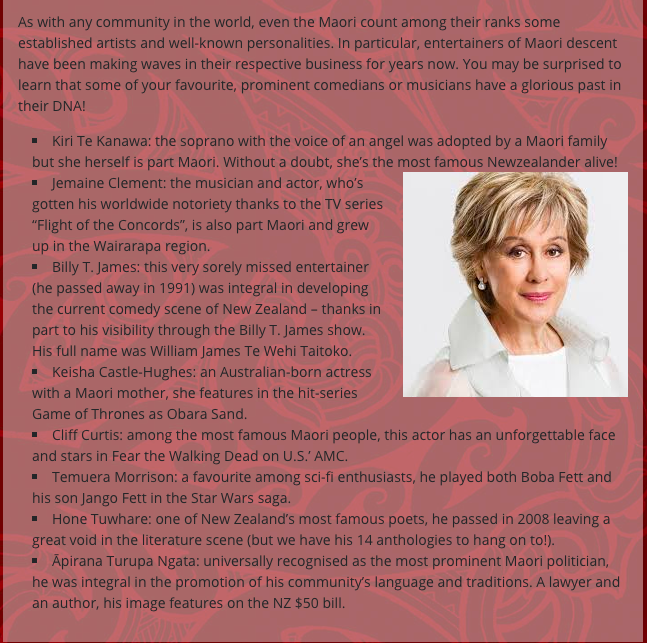
Write here... -
Kia ora...students and welcome to week 9. For this week you research who is your hero or role model and how this person has made a positive impact in your life.This will be produced in the form of a story board/ poster or video, and is an individual task.
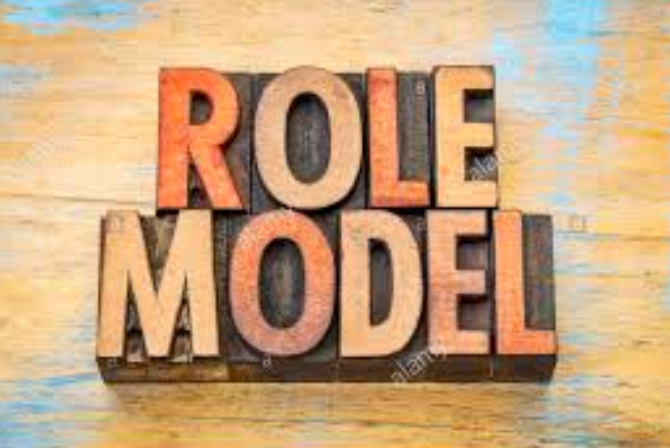
Achievement Objectives: Enter AO's here
Big Idea: Cultural Connections
Learning Intentions: We are learning to (WALT)...
- determine the most inspirational person in my life that has made a positive impact
- research the background of role model through a one on one interview and interviewing others whom know him/her
- indicate everything supportive, helpful, inspirational from this person
- examine why this person is valued in your life
- to produce my research in the form of a story board
Success Criteria: I can/have...
- I have researched my role model and created a story board to display why this person is an inspiration to me.
Activities:
- Reflect on the activities you had done in week 2 and 3 on research Maori Role models.
- Your task from this week is to research of someone whom s a role model to you. For this task, you need to think of someone that is known to you, whereby you have a personal connection. This can be your parent, sibling, aunt, uncle, grandparent, a teacher, member of your cultural organisation or coach.
- You may research on your role model by interviewing him or her to know more about them and their upbringing/ childhood/ education/ values.
- Think of the following questions to support you with the research:

- Template for your research: Name/ Culture/ Place of birth/ Cultural and family background/ Achievements/ What and why he/she is special to me/ impacts made that were supportive helpful, caring/ Why I value this person/ I want to be like him or her because...
- Create a first draft onto google docs. There after you need ato design a story board to show case your ROLE MODEL. This must be very creative and unique to present to the class.
- What is a story board: See examples on the white board.
- It is important that you include all elements in your story board: Title, caption, incredible images, bold clear text, 6-8 blocks, awesome introduction, middle and end, a flow to your work.
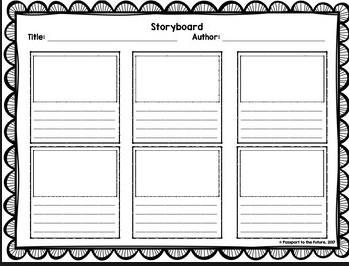
Resources:
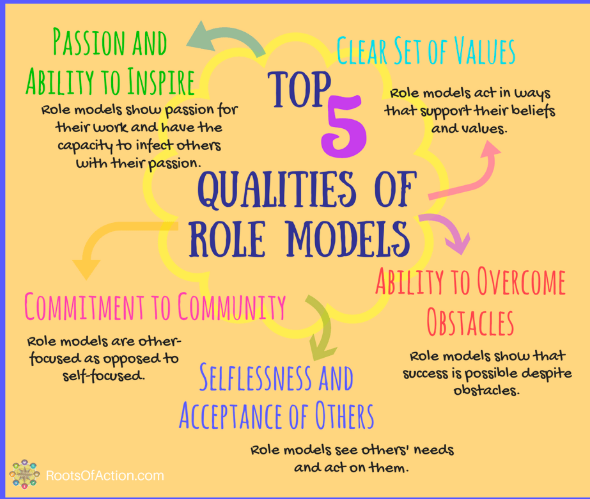
Homework:
Write here...PLAN & DO / WHAKAMAHI learning intentions:
- We are PLANNING... to deign a profile on a leaders I admire the most so that i can promote the ideas and values I live by as well as share unique and different information.
- I am planning to consult a role model in real life though skype/ interview/ online survey to see if they would respond to me as a pen pal / fan.
- I am planning to demonstrate a video that shows the highlights of been a good leader vs the pit falls of a bad leader
-
Good Morning and welcome to week 9.For this week you will be presenting your story boards/ posters or video's on My Role Model.
Your Checklist:
Research completed on your chosen role model
Ensure you have done a interview to understand your role models cultural and family background
Indicated all the reasons this person is valuable to you
Have one message for your role model, in hope to see it someday
Created this idea on a story board / poster or a 2 min. video that is visually attractive, attracts attention and has all the important elements.
Present your storyboard to the class.

PLAN & DO / WHAKAMAHI learning intentions:
- We are PLANNING... to deign a profile on a leaders I admire the most so that i can promote the ideas and values I live by as well as share unique and different information.
- I am planning to consult a role model in real life though skype/ interview/ online survey to see if they would respond to me as a pen pal / fan.
- I am planning to demonstrate a video that shows the highlights of been a good leader vs the pit falls of a bad leader
-
REFLECTION ON TERM 3 LEARNING AND INTRODUCTION TO TERM 4 CONTEXT.
Quiz: on leadersip on white board
Cross word puzzles on leadership

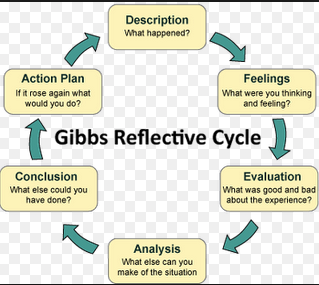
REFLECT / WHAIWHAKAARO learning intentions:
- We are REFLECTING...on the challenges and barriers in my learning
- WE are reflecting to critique and assess what make as good leader.
- We are reflecting on the ethics applied to our research and demonstration of Maori models ie using clear and accurate vocabulary/ information and pronuonsciations.
-
Kia ora...students and welcome to term 3. You have an exciting new context for this term, titled Earth and BEYOND. For this idea we will explore our solar systems, the structure of earth, the water cycle, maps( geographical and climate), how earth is are changing due to human impacts eg farming, fishing, e-waste, oil drilling etc.

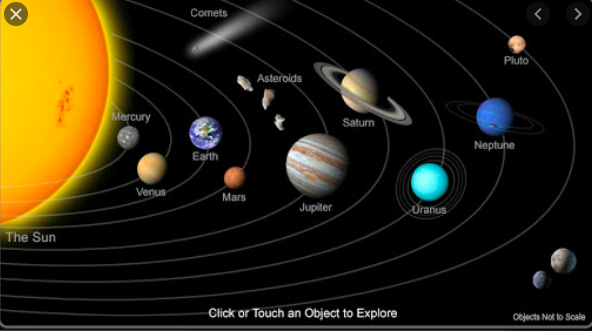
Success Criteria: I can/have...
- I have understood what our solar systems looks like and the may concepts linked to space and time
- I have read on the big bang theory and offered my view on this
- I have an understanding of how our solar system influences seasons on earth.
Activities:Testing for prior knowledge
A)Watch the video on our solar system. Write down key words that you have heard.
- A fascinating tour through our solar system, based on NASA's Science on a Sphere program.Also, based on the video create a simple representation of the solar system that gives you an understanding of the planets and their order from the sun. In pairs make a poster of the solar system encourage you to conduct research and learn more about the physical characteristics of each planet.You may use canva .com to design your posterC)Let us brainstorm words that link with space and time. Read this links to support you
Space Word Wall Vocabulary - Teach Starter
B)
- Research what is the big bang theory.
- See images on white board on on solar system. Create a word bank on all words that link with the solar system.You can use vocabulary creator app for this as it gives you the definitions. of each word identified.
- See video on our solar system.
- List the different planets and describe each one briefly in relation to the sun.List what would you find in the solar system.
- Who was the first astronaut to explore travel to space and when did this happen? Explain. this idea in detail with images.Whom is Nasa and discuss the theory of the first person in space.
- Research. the first man landing ion the moon. Where is NASA and various space stations on earth.
- Create an model on the solar system with your table group. Materials provided in class eg play dough and paper.
Resources:
ESA - Space for Kids - Our Universe - The Big Bang
StarChild: The Solar System
Homework:
Write here...EXPLORE / TŪHURA learning intentions:
- We are EXPLORING...key vocabulary and definitions linked to infinity and beyond with links to space and the galaxy.
- We are EXPLORING...to research what does our solar system looks like. Also understanding what my exist beyond our solar system.
- We are EXPLORING...o question if the big bang theory supports how our solar solar began. Or are there alternative theories.
EXPLORE / TŪHURA learning intentions:
- We are EXPLORING...to research and have an understanding of space, the structure of earth and how earth science that include atmospheric levels, water cycles and how are weather/seasons formed
- We are EXPLORING...how landscapes on earth are changing due to human activities and development
- We are EXPLORING...ideas on how local communities( around the world are affected by these activities.
-
Kia ora...students. This week you will explore the structure of earth, earths atmosphere, the water cycle and global warming.

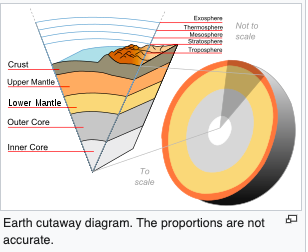

Achievement Objectives: Enter AO's here
Context: Earth and Beyond.
Learning Intentions: We are learning to (WALT)...
- research our planet earth with links to structure/ atmosphere/ water cycle and global warming
- identify images and understand key concepts.
- determine the cause of global warming and
Success Criteria: I can/have...
- understood the structure of earth and key factors that determine life on earth eg through the water cycle.
- examined and understood what is global warming and its effects on earth.
Activities:
- Research and paste a digram on the structure of the earth and indicate what are the different components.
- What us meant by magnetic field? examine the materials earth is made up of which is nickel iron. What do you understand by this material.
- Research and paste a diagram on earths atmosphere. List the different parts to the atmosphere and what gases may be found in each part.What is the purpose of the ozone layer?
- See video on earths atmosphere and list important vocabulary in your online document.
- Research and paste an image of the water cycle. Write a short paragraph on how the water cycle is formed.
- List with images the various clouds in earths atmosphere.
- What would happen to cloud formation if there was a drought?Explain with reasons.
- By testing your prior knowledge what id global warming. List important words by that link with this.
- Research and paste a diagram of what is global warming.
- What are greenhouse gas emission and what industries are likely to give these off.
- What is likely to happen if the co2 build up continues. How does this effect climate.
- Research one image of how climate change is effecting people and the environment. What would happen if this trend continues.
- Explain what is ozone depletion.
- Do you think climate change is causing sea level rise? How is this affecting our COASTS?
- See video on climate change and let us have a class discussion on this.
- By working in a team an infographic on your carbon footprint. Calculate the amount of gases and other materials you consume everyday that contributes to global warming.
Homework:
Write here...EXPLORE / TŪHURA learning intentions:
- We are EXPLORING...to research and have an understanding of space, the structure of earth and how earth science that include atmospheric levels, water cycles and how are weather/seasons formed
- We are EXPLORING...how landscapes on earth are changing due to human activities and development
- We are EXPLORING...ideas on how local communities( around the world are affected by these activities.
-
Kia ora...students for this week we will research coastal areas around the world and compare these to New Zealand.Also we will explore mapping skills when researching beaches/ shore lines/ and tourist destinations along coasts.
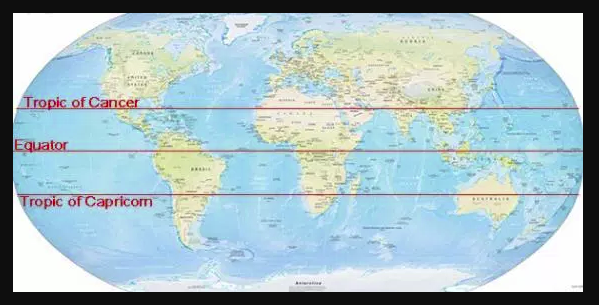
Achievement Objectives: Enter AO's here
Context: Erath And Beyond
Learning Intentions: We are learning to (WALT)...
- identify several coastal regions globally by using google earth and maps online.
- identify various types of maps and its key features
- compare coastal regions from around the world to new Zealand in terms of the ecology, geographical landscape and weather patterns.
- identify and examine the many uses of the coast: socially/ sports/ culturally/ tourism/historically and politically
- identify and examine problems around the coastal areas eg: pollution/disrespect/development/climate change
- identify coasts of New Zealand and its many treasures eg: cultural myths and legends/ ecological treasures/ discoveries
Success Criteria: I can/have...
- Examined the social/ environmental/ economic/ cultural and historical knowledge of coast lines offer to people globally and in New Zealand
Activities:
- Create a table researching the following information: use google maps/ google earth and identify 5 coastal belts around the world, including NZ. Indicate the region with pictures and the country or island with a map. Calculate the direction these locations are from New Zealand. See images on white board on various coastal lines globally: examine the landscape and topography of each coastal area. What are the similarities and differences.
- See topographical map on the white board: You will learn on keys such as longitude/ latitude/tropic of cancer/tropic of capricon/equator/ and directions. Indicate where there are coasts with these lines of latitude. Research further what these lines are and watch short video.
Search Results
- .Calculate directions from New Zealand with countries listed on the board.
- By working in teams of 3 choose one coastal regions from around the world. With Images examine the geography of this coastal belt. Who was the first to discover this are/ country/location: the first immigrants and their lifestyle.Discover what is unique about your chosen coastal belt: it is a place for overfishing/ tourism hotspot/ sustainable protected area/. Discuss if this coastal area has changes over time due to immigration/ pollution/ development or a serious weather condition like hurricanes. What has been done to protect this area( if any).See teacher example on white board on the case of Sri Lanka and Phuket.
- What laws are in place that country to protect the oceans and coastal belt.
- Discover what treasures are found on coastal belts. These can include a traditional myth or legend as well as sea/oceanic life/elements washed onshore.
- Choose one New Zealand location: Examine the map/ images/ first immigrants here/ geography/ the many uses of the coast including sports/ tourism/ fishing/ camping. How have people exploited the coastal regions of NZ.
- Research a news paper article that shows how climate has damaged a coastal area in New Zealand. What are your toughts on this.
- Research one Maori cultural myth or legend that links with coastal areas in NZ.
Resources:
The Equator and Tropics - Important Lines of Latitude - ThoughtCo
Homework:
Write here... -
Kia ora...students. For this week you will research how we measure climate temperature/wind speed and wind direction. You will thereafter choose one weather instrument to design and create in class.Some teams will create a product that addresses the issue of problems along coastlines eg:
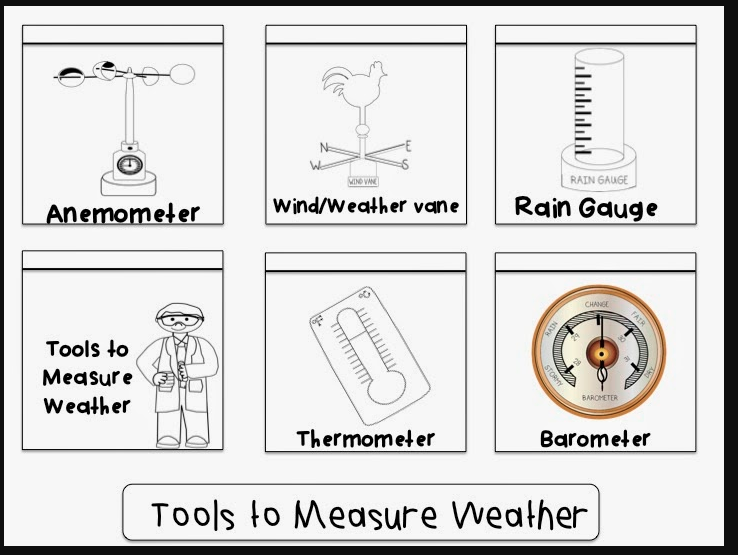
Achievement Objectives: Enter AO's here
Context: Earth and Beyond.
Learning Intentions: We are learning to (WALT)...
- understand how to measure and read temperature/ wind speed and wind directions
- determine the instruments used to read these climatic conditions.
- design and create a weather instrument such as a wind vine or wind sock
- showcase how your instrument works
Success Criteria: I can/have...
- understanding climatic conditions using weather instruments
- creating a weather instrument that is also unique and interesting
Activities:
1) Write down the various weather instruments you know and the purpose of each tool.
2)See images on the board on weather instrumentsIdentify each one and its purpose . These include the anemometer/rain guage/thermometer and barometer.
3)See video on weather instruments and the function of each instrument. Also complete the attached worksheet.
4)Complete the cross word on weather instruments:
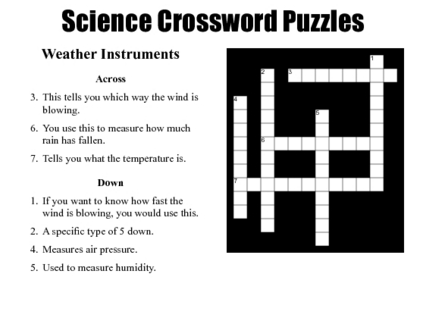
5) By working in teams of three choose one weather instrument you wish to design and create in class such as a wind sock. Let this be useful / innovative and unique in design.
Homework:
Write here...FOCUS / ARONGA learning intentions:
- We are FOCUSING...on case studies from around the world that showcase how people have exploited resources on earth due to economic gain eg food waste, oil drilling, e-waste, poaching, deforestation,
- We are FOCUSING on these activities impact on the environment and how communities and effected from these environmental problems
- We are FOCUSING...on creating solutions to reduce/ resolve these problems
-
Kia ora...This week we will examine how coast lines are changing due to the influence of the Pacific Garbage Drift.In teams of 4/5 think of one type of human activity that is altering our planet eg oil drilling, e-waste, poaching or any other activity.
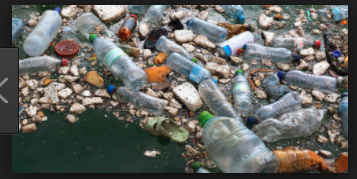
Achievement Objectives: Enter AO's here
Context: Earth and Beyond
Learning Intentions: We are learning to (WALT)...
- determine what is the Pasific Garbage Drift and its history of origination
- Analyse the journey of plastic from factory to oceans:
- Examine what is consumer responsibility
- Examine the impacts of plastic pollution in the ocean
- Find possible solutions to reduce this problem.
Success Criteria: I can/have...
- Understood the cause and impacts of Pacific Pacific drift on oceans and coastlines.
Activities:
- Define what is Pacific Plastic Drift also known as the garbage patch of the pacific ocean. Research your answer.
- Provide a map to determine the location and size of the gabage patch.
- See images on white board of what this platsic drift looks like. How do you feel about this issue,
- Research when was the plastic drift first discovered and whom is responsible for this global pollution activity.
- Show a graph that highlights this problem . Discuss what the graph means.
- What impacts do you think plastic pollution creates to marine life/ oceans/air and coastlines. Discuss with images
- See picture of Indonesian man on kayak in the middle of plastic pollution in pacific. What do you think are the two possible reasons he is there!
- With a flow chart discuss the journey of plastic from factories to oceans. Discuss your views here as well.
- Provide ways in which plastic can be reduced and also ways of this not entering the ocean.
- Create a word ban with definitions that include: biodegradable/photodegradable/consumer awareness/ pollution/
Homework:
Write here...FOCUS / ARONGA learning intentions:
- We are FOCUSING...on case studies from around the world that showcase how people have exploited resources on earth due to economic gain eg food waste, oil drilling, e-waste, poaching, deforestation,
- We are FOCUSING on these activities impact on the environment and how communities and effected from these environmental problems
- We are FOCUSING...on creating solutions to reduce/ resolve these problems
-
Kia ora...students. Our learning journey from this week will explore how animals are poached and hunted illegally and unethically in New Zealand and the globe.
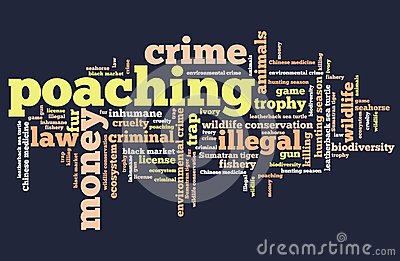
Achievement Objectives: Understand how people’s management of resources impacts on environmental and social sustainability.
Context: Earth and Beyond
Learning Intentions: We are learning to (WALT)...
- understand the definitions of poaching and hunting
- Research what species are poached or hunted in both NZ and Oceania(examples and case studies)
- Research the numerous impacts and consequences of poaching and hunting of animals
Success Criteria: I can/have...
- Understood the meaning of poaching and hunting and examined examples of species that are subjected to this both in New Zealand and other countries in the world.
- examined the environmental, economic, socio-cultural and political impacts of this activity.
- think critically about this issue
Activities:
- By using mind-map such as coggle.com, express what is poaching and and hunting, as well as use words that link with this issue
- See the image of animals under treat in the world. What are your thoughts?
- Research a few species that are poached both in New Zealand and Oceanic countries and other countries.. Consider if these animals are hunted or poached legally/ and or unethically. Research a map/s that illustrate this problem.
- Why do you think poaching is common throughout he world. What do poachers do with the animal and animal products.
- Research the many many impacts and consequences poaching and hunting may have.
- What are you thoughts and judgements about this activity
- What is trophy hunting? show examples and provide your views on this.
resources:
What is Poaching? - Animal Rights - About.com
animalrights.about.com › ... › Hunting, Wildlife Management and Endangered SpeciesPoaching Facts
Search Results
The Devastating Effects of Wildlife Poaching | One Green Planet
How does poaching affect the environment? | Reference.com
Cause & Effect of Animal Poaching | AnimalPoaching
Vanuatu - No Animal Poaching
www.noanimalpoaching.org/animal-poaching-news/category/vanuatuHomework:
Write here...FOCUS / ARONGA learning intentions:
- We are FOCUSING...on case studies from around the world that showcase how people have exploited resources on earth due to economic gain eg food waste, oil drilling, e-waste, poaching, deforestation,
- We are FOCUSING on these activities impact on the environment and how communities and effected from these environmental problems
- We are FOCUSING...on creating solutions to reduce/ resolve these problems
-
Good Morning...students. For this week you will explore ideas on Electronic waste that impacts on the environment both in New Zealand and abroad.
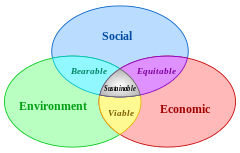
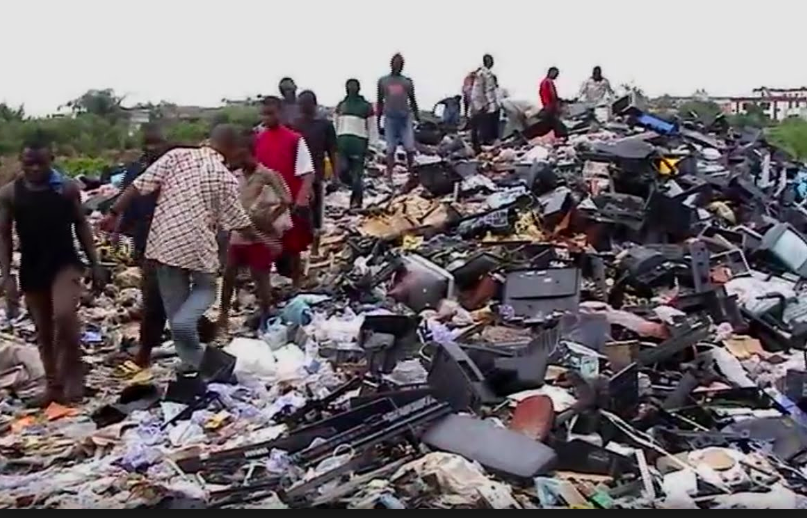
Learning Intentions: We are learning to (WALT)...
- understand meaning to environment and sustainability
- researched and understood Yeld's 9 principles to sustainability
- working in teams to define e waste, and its implications onto the environment both in NZ and aborad.
Success Criteria: I can/have...
* understood important concepts and Principles that with environment and sustainability
conducted team research on E- waste/ global and local impacts/ consequences and policy"s on this problem
Activities:1) Define the environment and sustainability
2) Create a mind a map of all issues that effect our environment that therefore calls for the need for a more sustainable world
3) Understanding sustainability in depth through Yeld's nine principles. Examine each of these principles and apply to examples globally
4) By choosing an idea from the mind map list: work in groups on the following
Examples list: E Waste/ Waste
First class discussion on what is e-waste and how this is a problem globally. Brainstorm ides on impacts onto the environment
5) examine how electronic devices are disposed off into the environment. Examine what are the environmental consequences as a result of this disposal.
6. Choose one location globally and discuss the reason / impacts of this for this problem onto people, economy and the environment
7)Why is there a need for sustainable practices for this issue.
7) Research New Zealand policy/ plan or practice around e-waste.
Resources:
Mind Map, articles on Yeld's 9 principles/ images on e-waste/graphs on disposal in USA of e/waste/ images on impacts and NZ
Homework:
Write here... (please clearly identify the due date of the homework)What is Electronic Waste (e-waste)? - Definition from Techopedia
https://www.techopedia.com/definition/2108/electronic-waste-e-waste -
Presentations due this week. In teams, present your idea on how human activities have impacted on our planet.
In your discussions discuss one key location, the impacts and consequences to the problem onto the environment, people and the economy, as well as solutions to reduce this problem.
Each team has 8mins to present their idea followed by questions and discussions.

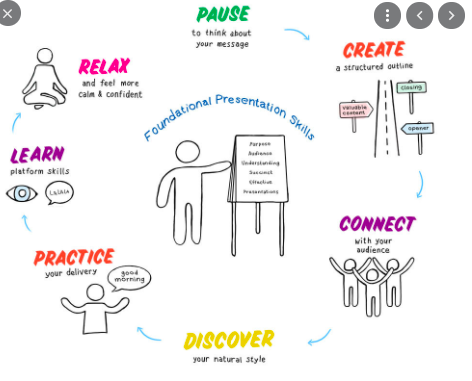
PLAN & DO / WHAKAMAHI learning intentions:
- We are PLANNING... to create presentation to document your ideas on environmental problems that effect communities. that we can...
- We are Planning to create a visual that showcases alternative ideas such as colonising other planets
-
Online quiz and games . Online learning with Miss MacDonald. Ideas include protecting our environment by consuming/ purchasing less.
-
Introduction into next terms Context and Reflection.

4) Introduction into term 4's Context. Ideas to think about:REFLECT / WHAIWHAKAARO learning intentions:
- We are REFLECTING...on following the steps of research skills
- We are reflecting our independant task of letter writing, that include ideas and structure
- WE are reflecting on our ethics used during research and showcasing of information, such that it is not offensive to any specific group of people
REFLECT / WHAIWHAKAARO learning intentions:
- We are REFLECTING...on the challenges we experienced in our learning as well as to identify gaps we need to address.
-
Kia ora...students and welcome to term 4. For this term the learning context is Wet and Wild which links with the study of our oceans, coasts and wildlife near oceanic coastlines.You will explore the value of oceans/ marine life eg fishing ideas linked to tourism development as well as irresponsible practices that affect these features.
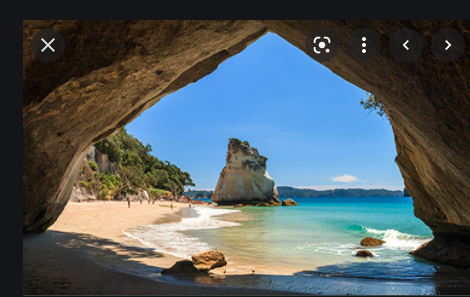
Success Criteria: I can/have...
- Understand key concepts linked to oceans, coastlines and the environment
- Research Map of Nz and look for key features eg important landmarks and beaches
- list of why oceans and coastlines are import
Activities:Use padlet to document your reaserch findings
- List words that link with the ocean, coastlines and wildlife found along NZ coastlines.
- Find definitions of pollution, destruction, economic development tourism and ocean tourism
- Research and paste a map of NZ that show important features such as lighthouses, places of interest and other natural features such as sand-dunes, seashells, rocks, coves, etc. Use images to support your findings.

4) List why are oceans important? What are the various activities oceans are used for. Discuss in detail the importance of ocean/ beach tourism in NZ. Where does this occur . What are the benefits. What are the consequences of these benefits eg mass tourism and pollution. Discuss your views here.
See video :
At the tippity top of the North Island — west of Cape Farewell — lies Wharariki Beach, known for its larger-than ...13/04/20195) Research at leat one newspaper article that shows how beach tourism can negatively affect our coastlines and or oceans. eg: READ these as an example then find your won article:
Auckland's polluted beaches: the five big questions - NZ Herald
6) what do you think of this concept and video: NZ beaches polluted. Provide solutions to improve this image whereby we maintain a status quo of been 100% Pure. -
Kia ora...This week we will examine how coast lines are changing and may affect new Zealand due to the influence of the Pacific Garbage Drift.

Achievement Objectives: Understand that events have causes and effects.Understand how formal and informal groups make decisions that impact on communities.
Big Idea: Wet and Wild
Learning Intentions: We are learning to (WALT)...
- determine what is the Pacific Garbage Drift and its history of origination
- Analyse the journey of plastic from factory to oceans:
- Examine what is consumer responsibility
- Examine the impacts of plastic pollution in the ocean
- Find possible solutions to reduce this problem.
Success Criteria: I can/have...
- Understood the cause and impacts of Pacific Pacific drift on oceans and coastlines.
Activities:
- Define what is Pacific Plastic Drift also known as the garbage patch of the pacific ocean. Research your answer.
- Provide a map to determine the location and size of the garbage patch.
- See images on white board of what this plastic drift looks like. How do you feel about this issue,
- Research when was the plastic drift first discovered and whom is responsible for this global pollution activity.See this video and provide your views:
- Show a graph that highlights this problem . Discuss what the graph means.
- What impacts do you think plastic pollution creates to marine life/ oceans/air and coastlines. Discuss with images. Discuss the impacts this garbage patch will have on NZ coastlines. Predict what could happen.
- See picture of Indonesian man on kayak in the middle of plastic pollution in pacific. What do you think are the two possible reasons he is there!
- With a flow chart discuss the journey of plastic from factories to oceans. Discuss your views here as well.
- Provide ways in which plastic can be reduced and also ways of this not entering the ocean.
- Create a word ban with definitions that include: biodegradable/photodegradable/consumer awareness/ pollution/
Homework:
Write here...EXPLORE / TŪHURA learning intentions:
- We are EXPLORING...key words that link with Ocean and Coast such as coastal-belt, aquatic life, ecosystems, protection and preservation, tourism, recreation
- We are EXPLORING...to research the map of NZ coastal belt and the many activities that are found that brings benefits to us
- We are EXPLORING...o research how our oceans support people through economic activities and leisure
-
Kia ora...students and welcome to week 3. For this week we will explore what is oil drilling and how this impacts onto marine life, coastal belts of NZ. We will also draw comparisons to cases from around the world. Economic impacts will also be examined.
Achievement Objectives: Events have cause and effect.
Big Idea: Wet and Wild
Learning Intentions: We are learning to (WALT)...
- to explore the definition of oil drilling
- locate areas whereby extraction occurs
- determine the positive impacts like economic rewards it may bring
- determine the challenges? environmental problems attached to oil drilling
Success Criteria: I can/have...
- Understood the definition, map-work of location in NZ, impacts and solutions around oil drilling in New Zealand.
Activities:
- Define, thorough research what is oil drilling. Watch video on white board. 2) See the map of oil drilling in New Zealand. Identify the locations? cities and coastal regions here. Research the geographical identity of these areas( landscape/ marine life/ climate/ important heritage or cultural sites), etc
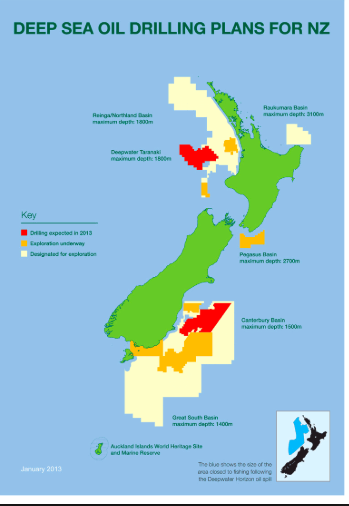
3) Read the aritcile below and explore the economic impacts oil drilling may bring to New Zealand:
Oil Drilling Benefits | Sciencing
by D Kreutzer - Cited by 2 - Related article4\4)Watch the video on the environmental harm of oil drilling:23K views12 years agoA Link TV special: The new feature-length documentary Crude Impact directed by James Wood examines how deeply our current ... 5) Explore the dangers of oil drilling to our natural environment.Draw a table with the challenges/ images and your views indicated.Read this article for support:7 ways oil and gas drilling is bad for the environment | The Wilderness ...
6) Do you think this should be legalised in new Zealand. Explain your answer.Which companies are responsible for oil exploration in NZ7) Examine the map below and express/ evaluate your views on this: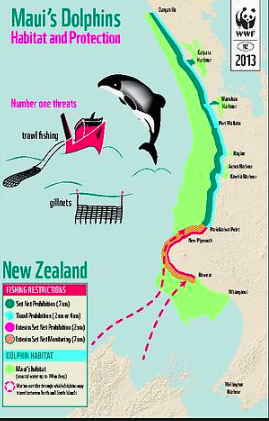 8) Provide alternatives and solutions to oil drilling: Read the following articles for support:Homework:8.2K views6 years ago
8) Provide alternatives and solutions to oil drilling: Read the following articles for support:Homework:8.2K views6 years agoOffshore oil drilling is of major concern to New Zealand because of the alarming environmental and economic risks that face our ...
Write here...EXPLORE / TŪHURA learning intentions:
- We are EXPLORING...key words that link with Ocean and Coast such as coastal-belt, aquatic life, ecosystems, protection and preservation, tourism, recreation
- We are EXPLORING...to research the map of NZ coastal belt and the many activities that are found that brings benefits to us
- We are EXPLORING...o research how our oceans support people through economic activities and leisure
-
Kia ora...students and welcome to week 4. Our focus this week is to examine the fishing industry in NewZealand and draw comparisons to Oceania.Also, continue working on your research project.

Achievement Objectives: Enter AO's here
Big Idea: Wet and Wild
Learning Intentions: We are learning to (WALT
- Explore various activities that contribute to the fishing industry in New Zealand.
- Research the cultural/social/economic/environmental and political impacts of the fishing industry in NZ
- Understand where our fish comes from and what are the main sources of fish we rely on
- Research if people comply to laws and regulations in the fishing industry
- Made comparisons to any country in the oceania.
Success Criteria: I can/have...
- Understood concepts and definitions that relate to the fishing industry in New Zealand
- Researched that fishing is both a commercial and tourism industry
- Examined in detail the social/ cultural/ economic/ environmental and political impacts of the fishing industry in NZ
- understood where our main sources of fish come from and how it is fished
- Examined whether people comply to laws and regulations in NZ
- Drawn comparisons to one country in the Oceania.
Activities: Write using an infographic: images with detailed information.
- See images/ maps and video on fishing in new Zealand. Analyse each visual presented in class.
- Define what is meant by the fishing industry. Explain why fishing is important in New Zealand.
- By using maps and images show where in NZ commercial fishing is occurs. Examine what fish are are sources and the procedure( boats/trawls/ tankers/ nets/rods for fishing. Are people complying to laws and regulations / Discuss.
- Also show examples of ecotourism, where people fish for leisure/ s[ports and as family food provisions. Discuss how these fish are sources/ location and whether people follow laws and regulations as well.
- Research using examples the social/ cultural/economic/ environmental and political impacts of the fishing industry in NZ. Make good comparisons to the Oceania.
- Express your views if you think people do not comply with New Zealand's fishing laws and regulations. Also identify, if possible if some fish are endangered or overfished.
- Compare your information to any country located in the oceania eg. Tonga or Fiji.
- Additional work if completed 1-5: Research if fish is a cultural symbol or significance to any one culture in Oceania. Explain which country/ culture/ fish and why with images.
Resources:
Fishing industry in New Zealand - Wikipedia
Homework:
Write here...FOCUS / ARONGA learning intentions:
- We are FOCUSING...on developing an understanding of oceanic rewards such as tourism, recreation, fishing and and oil drilling
- We are FOCUSING...on identifying the problems human activities bring to these oceans/ coastal belts and to describe the impacts in depth
- We are FOCUSING... on explaining why human activities are necessary yet impose a threat to our oceans and coasts
FOCUS / ARONGA learning intentions:
- We are FOCUSING...on developing an understanding of oceanic rewards such as tourism, recreation, fishing and and oil drilling
- We are FOCUSING...on identifying the problems human activities bring to these oceans/ coastal belts and to describe the impacts in depth
- We are FOCUSING... on explaining why human activities are necessary yet impose a threat to our oceans and coasts
-
Kia ora...students and welcome to week 5! This week you will continue to explore ideas on marine life and sustainability.
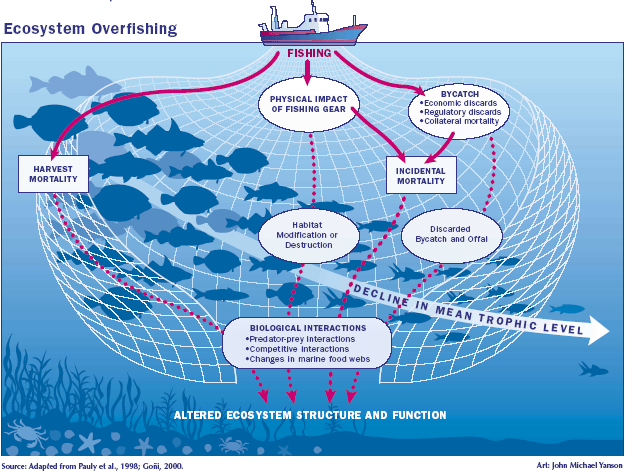
Achievement Objectives: Enter AO's here
Big Idea: Wet and Wild
Learning Intentions: We are learning to (WALT)...
- Reflect on last weeks learning on environmental issues affecting marine life
- Research the need for aquariums and some species found here
- Think comprehensively of the human impacts and consequences to marine life
- Consider Global/ Governmental and local solutions to these impacts
Success Criteria: I can/have...
- Created an infographic that shows the human impacts/ consequences of fishing onto marine life and provided unique and interesting solutions to problems identified.
Activities:
- Reflect on your learning from the previous session on marine life are affected by pollution, etc.
- In pairs start brainstorming your ideas where you include the following:why is there a need to conserve our marine life/ Does KT protect some species well? list some species found here/ discuss the human impacts of over fishing onto marine life and its consequences/ consider solutions like Greenpeace, stricter laws in place/ local education for the public/ use visual/ images that link well with your ideas.
- Thereafter, create an infographic( creatively designed chart) on your ideas. Make sure your images link well to your information.
- Spell check and get a buddy to check your work for errors before submitting.
- This can be digital or paper created.
- Submission this week
Resources:
Search instead for Human impacts onto marine life
Homework:
Write here... -
Kia ora...students.For this week our key focus is to examine the many impacts tourism brings to a host country, especially along coastlines. Here both benefits and challenges will be examined.

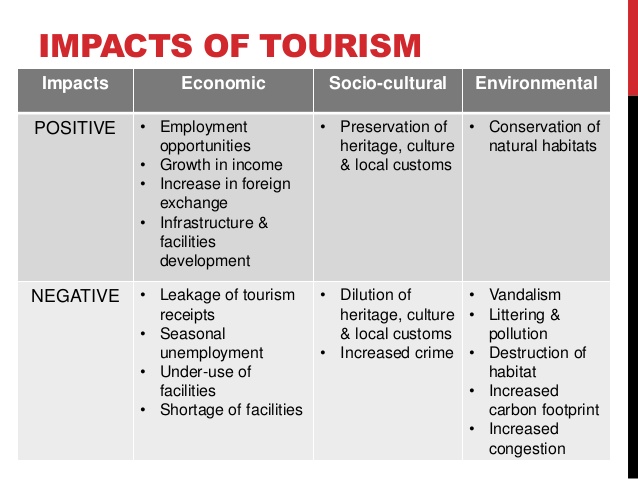
Achievement Objectives: Enter AO's here
Big Idea: Wet and Wild
Learning Intentions: We are learning to (WALT)...
- research the economic impacts of tourism where we analyse graphs and other statistics
- examine the social cultural impacts tourism has onto both hots and visitors
- examine the environmental impacts tourism may bring where mass vs alternative is assessed
- determine the impacts that may be both beneficial or a challenge as a result of tourism
- link all these impacts precisely to our tourism destinations.
Success Criteria: I can/have...
- examined in detail the economic/ social/ cultural and environmental impacts tourism brings onto the host country
- determine how mass tourism has an effect as opposed to alternative responsible tourism
Activities:
- list various beach activities in NZ and why these important in NZ and to local communities.View images on graphs on the white board that show how NZ has benefited from the tourism industry in term of employment and money entering the country. What are your thoughts here.( Before Covid19 pandemic),Show many benefits it brings.
- Examine the image on how westerners exploit local cultures through disrespect of local values. Provide your views on this image.
- See video on the environmental destruction tourists bring to some countries. Provide your views here. Research the destruction along beaches and coastlines. What impacts will be onto marine life and bird life as well.
- Research the economic/ social/ cultural and environmental impacts tourism brings to the destinations your are studying. Use images/ statistics/ political cartoons as evidence to support your arguments.
- Your information should indicate both positive and negative impacts.
- Examine how does mass tourism contribute to harm and think of alternative ways to reduce this, such as Responsible tourism.
- Watch and discuss s a class.
100% Pure Crowds: Is over-tourism ruining New Zealand's ...
www.stuff.co.nz › travel › news › 100-pure-crowds-is-ov...The crowds at Hot Water Beach. READ MORE: * Too many tourists: Should we limit visitor numbers to NZ ...5/09/2019
Homework:
Write here...Positive & Negative Effects of Tourism | USA Today
Negative Impacts of Tourism - The Responsible Traveler Guide
PLAN & DO / WHAKAMAHI learning intentions:
- We are PLANNING... to consult with Auckland city Council on steps taken to protect beaches/ oceans in and around Auckland: Free from pollution/ overfishing and mass tourism.
- WE are planning to prepare and design a power point presentation, offering solutions from a Youth Perspective to protect our local beaches.
-
Kia ora...students.For this week we continue with our key focus is to examine the many impacts tourism brings to a host country, especially along coastlines. Here both benefits and challenges will be examined.
Also to examine wild life near coastlines and within our marine ecosystems. To suggest ways to protect these from harm ie creating a sustainable environment for our national treasures( wildlife).
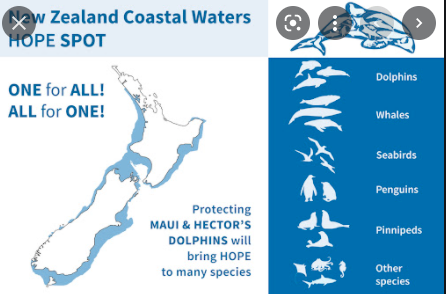

Achievement Objectives: Enter AO's here
Big Idea: Wet and Wild
Learning Intentions: We are learning to (WALT)...
- research the economic impacts of tourism where we analyse graphs and other statistics
- examine the social cultural impacts tourism has onto both hots and visitors
- examine the environmental impacts tourism may bring where mass vs alternative is assessed
- determine the impacts that may be both beneficial or a challenge as a result of tourism
- link all these impacts precisely to our tourism destinations.
- Researching the wildlife that coexist along our coastlines in Nz AND IN THE OCEANS
- Identifying ways to protect these animals from exploitation
Success Criteria: I can/have...
- examined in detail the economic/ social/ cultural and environmental impacts tourism brings onto the host country
- determine how mass tourism has an effect as opposed to alternative responsible tourism
Activities:
New Activity: List the animals both along coastlines and in the oceans that found in NZ
Why are our national treasures or ecologically important.
Discuss how these are exploited eg through over fishing/ pollution. urban development and tourism.
Suggest ways to protect these animals. Create a poster that promotes responsible practices around our coasts and oceans that would allow for a sustainable future for these animals .
- list various beach activities in NZ and why these important in NZ and to local communities.View images on graphs on the white board that show how NZ has benefited from the tourism industry in term of employment and money entering the country. What are your thoughts here.( Before Covid19 pandemic),Show many benefits it brings.
- Examine the image on how westerners exploit local cultures through disrespect of local values. Provide your views on this image.
- See video on the environmental destruction tourists bring to some countries. Provide your views here. Research the destruction along beaches and coastlines. What impacts will be onto marine life and bird life as well.
- Research the economic/ social/ cultural and environmental impacts tourism brings to the destinations your are studying. Use images/ statistics/ political cartoons as evidence to support your arguments.
- Your information should indicate both positive and negative impacts.
- Examine how does mass tourism contribute to harm and think of alternative ways to reduce this, such as Responsible tourism.
- Watch and discuss s a class.
100% Pure Crowds: Is over-tourism ruining New Zealand's ...
www.stuff.co.nz › travel › news › 100-pure-crowds-is-ov...The crowds at Hot Water Beach. READ MORE: * Too many tourists: Should we limit visitor numbers to NZ ...5/09/2019
Homework:
Write here...Positive & Negative Effects of Tourism | USA Today
Negative Impacts of Tourism - The Responsible Traveler Guide
PLAN & DO / WHAKAMAHI learning intentions:
- We are PLANNING... to consult with Auckland city Council on steps taken to protect beaches/ oceans in and around Auckland: Free from pollution/ overfishing and mass tourism.
- WE are planning to prepare and design a power point presentation, offering solutions from a Youth Perspective to protect our local beaches.
-
-
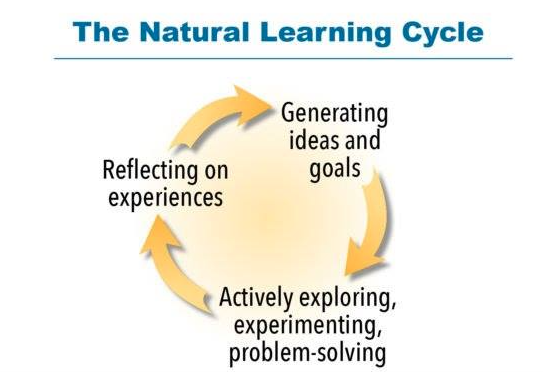
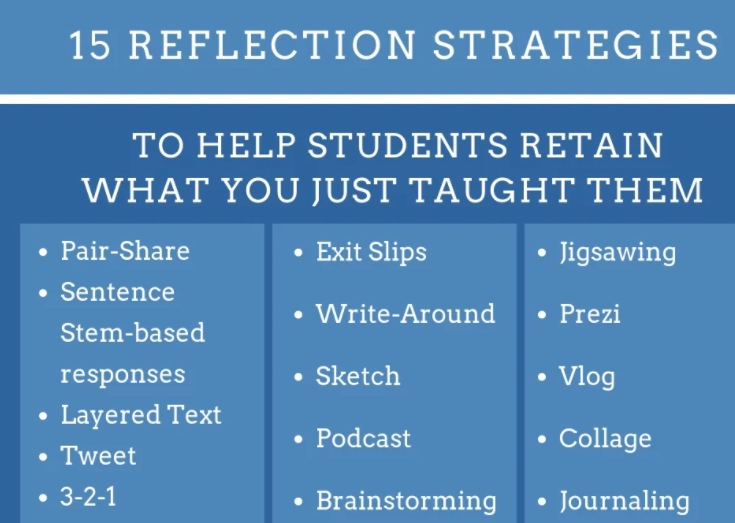
REFLECT / WHAIWHAKAARO learning intentions:
- We are REFLECTING...on measuring how many resources we have read and understood about the problems and impacts of human activities in our oceans.
- We are reflecting on the quality of writing we have constructed. Asking questions such as who is our audience? what emotive language is been used/ have we used constructive social concepts.
REFLECT / WHAIWHAKAARO learning intentions:
- We are REFLECTING...on measuring how many resources we have read and understood about the problems and impacts of human activities in our oceans.
- We are reflecting on the quality of writing we have constructed. Asking questions such as who is our audience? what emotive language is been used/ have we used constructive social concepts.

